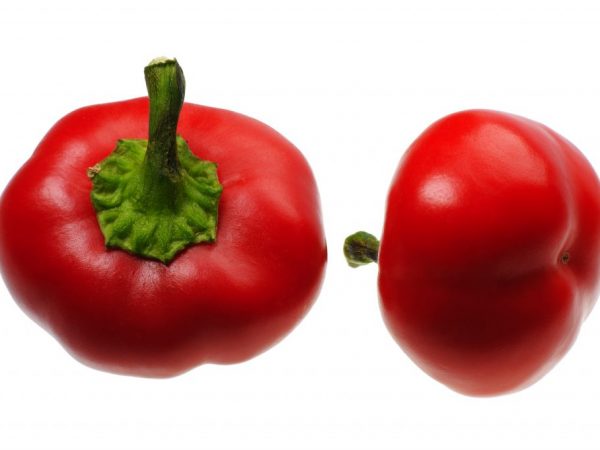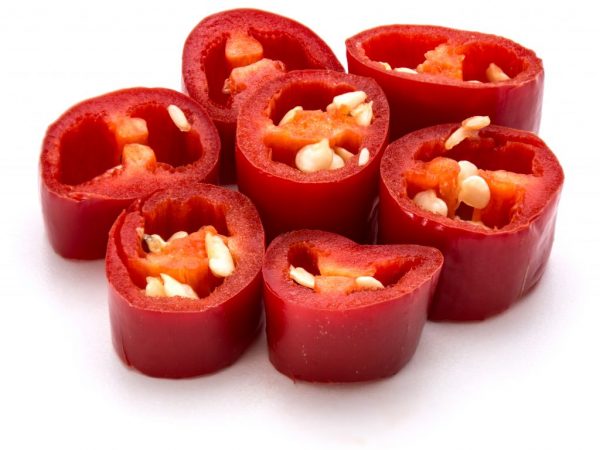Characteristics of Ruby salad pepper
Ruby pepper is a type of bell pepper popular with gardeners. A detailed description of the variety is presented in the article.

Ruby salad pepper
Characteristics of the variety
Ruby pepper appeared in Moldova. This hybrid is the result of crossing of two varieties: Gift of Moldova and Novogogoshary. A distinctive feature of the resulting hybrid is its unpretentiousness and cold resistance.
Refers to standard plants. Despite its powerful deciduous part, the culture is quite compact. Ruby pepper reaches a height of 45 to 60 cm.
Ruby hybrid belongs to mid-season varieties. The technical maturity of the fruits occurs 130 - 150 days from the emergence of full shoots.
Fruit
Quite large fruits of Ruby pepper have a flattened shape. Weight ranges from 110 to 160 grams. Fruits are distinguished by juicy and fleshy walls, the thickness of which ranges from 7 to 10 mm. Some specimens boast a wall thickness of 1 cm. The color of the fruit depends on the degree of maturity. Perfectly ripe paprika has a dark red color.
The hybrid is characterized by a high yield. With proper agricultural technology and timely care, gardeners remove up to 5 kg of fruits from each square meter.
Paprika of this variety has excellent taste. You can use the fruits already at the stage of technical ripeness. Such a vegetable is perfect for summer fresh salads, any kind of heat treatment, canning, pickling.
Planting varieties
To obtain good yields, crops are recommended to be grown in seedlings. Start sowing seeds in the second half of February. For regions with a rather harsh climate, gardeners recommend sowing a hybrid for seedlings in mid-March.
Germinating seeds
Vegetable growers advise to germinate seeds before planting pepper. Take seed material two to three years ago. Fresh seeds will produce a plant that does not have the distinctive characteristics of the mother plant.

Choosing seeds
When germinating seeds, follow the instructions:
- Treat the selected seed material with a pink solution. The manganese concentration should not exceed 1%. Hold the seeds in this solution for 10-15 minutes, mix the contents several times during this time. Floated seeds are not suitable for planting.
- Catch the seeds that have sunk to the bottom. Dry them.
- Line the bottom of the prepared container with gauze or cloth. Spread the prepared seed material on it.
- Pour in enough liquid to wet the fabric well, but the seeds should not float. For these purposes, use water or an ash solution. The water must be pre-settled and at room temperature. Prepare an ash solution from one liter of water and one tablespoon of ash.
- Cover the container with cling film. During this period, create a favorable temperature regime for the seeds. The comfort zone ranges from 25 to 300C.
Sowing seeds
After the seeds hatch, start sowing them.Fill the containers with the fertilized soil mixture to 1/3 part. Do not plant seeds deeper than 5 mm. Sprinkle the seeds with a mixture of sand and soil. For each piece of sand, take one piece of soil. This will give lightness to the ground. It will be easier for sprouts to break through such a layer of earth.
We cover the containers with cling film and leave, maintain the temperature at least 25 C. As soon as the first shoots appear, remove the film.
First shoots
For normal development, seedlings of a vegetable need twelve hour daylight hours. In winter, there is not enough natural light. Solve the problem with the lack of light by installing additional lamps. Remember to let the plant rest at night.
Maintain the temperature during the day at 20-25C. At night, the thermometer should not fall below 18C.
Top dressing
The sprouts of the hybrid require feeding. Carry it out after the first two true leaves appear. Dissolve a mixture of 10 g of urea, 40 g of superphosphate and 10 g of potassium salt in 10 L of water. Pour the seedlings with the resulting solution.
The culture will gratefully accept foliar feeding. To do this, make a solution based on a growth promoter and spray the plants. Perform this procedure on cloudy days. After that, do not expose the seedlings on the windowsill for one or two days.
Seedling hardening
Two weeks before planting the sprouts in a permanent place, begin to harden the plant. In the early days, take the plant outside for one to two hours. Gradually increase the time the seedlings are in the fresh air until daylight hours. Leave the plants outside for a day just before transplanting.
When hardening paprika seedlings, make sure that the plant is not in drafts, not exposed to too sharp changes in temperature.
Bush care
Ruby sweet pepper is suitable for growing both in the open field and in greenhouses. Seedlings are transferred to the beds at the age of 25 - 30 days. For proper plant development and large yields, create favorable growth conditions for the hybrid.
- The culture does not like frequent watering. One or two abundant watering per week is enough for the plant. Use standing and warm water.
- Remember to loosen and weed the pepper beds. This will create lightness in the soil, saturate it with oxygen, and get rid of weeds.
- Apply fertilizers on time. Carry out the first feeding in 10 - 14 days after planting the seedlings. Use organic fertilizers. Carry out the next introduction of nutrients during the flowering period of the culture. After three weeks, feed the hybrid with mineral fertilizers.
- Treat the plant with insecticides to prevent small insect infestations.
- The culture is resistant to many diseases, including verticillary wilt. Do not neglect preventive measures. Spray the culture with fungicides.
The Rubinovy peppercorns are perfect for growing on your backyard. Proper care and adherence to agricultural technology will allow you to enjoy the fruits of the pepper that exude an incredible aroma.


